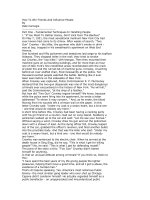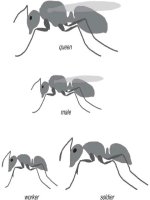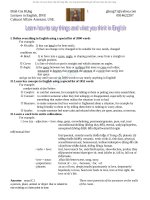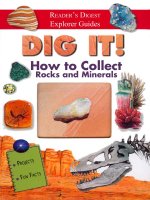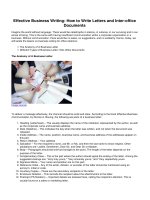Water treatment processes on how to reduce, remove, and disinfect water contaminants
Bạn đang xem bản rút gọn của tài liệu. Xem và tải ngay bản đầy đủ của tài liệu tại đây (1.96 MB, 61 trang )
THAI NGUYEN UNIVERSITY
UNIVERSITY OF AGRICUTURE AND FORESTRY
MANUEL VICTOR ALVIAR RAMIREZ
TOPIC TITLE: Water Treatment Processes on how to Reduce,
Remove, and Disinfect Water Contaminants
BACHELOR THESIS
Study Mode:
Full-Time
Major:
Environmental Science
Faculty:
Advanced Education Program
Batch:
(2014-2018)
Type:
On-The-Job Training (OJT)
Thai Nguyen, 25/9/2018
DOCUMENTATION PAGE WITH ABSTRACT
Thai Nguyen University of Agriculture and Forestry
Degree Program
Bachelor of Environmental Science and Management
Student Name
Manuel Victor Alviar Ramirez
Student ID
DTN1454290090
Thesis Title
Water Treatment Processes on how to Reduce, Remove,
and Disinfect Water Contaminants
Supervisor (s)
PHL, Ms. Rochelle L. Retamar / VN, Nguyễn Văn Hiểu
Supervisor
Signature:
Abstract: Piggeries small or industrial are one of many contributors
to waste water pollutants, from the urine, droppings, feeds, and excrements
produced by swine. With technology as advanced as now, Department of
Science and Technology (DOST) created a device called a biogas digester.
Which gets rid of common pollutants such as biochemical oxygen demand
(BOD) and chemical oxygen demand (COD), total nitrogen (TN) total
phosphorous (TP) total suspended solids (TSS) and total volatile solids
(TVS), but the biogas digester does not have the capability to eradicate some
pollutants such as (TP) and (TS) completely. Environment and Biotechnology
Division (EBD) has come up with an Aerobic treatment of Anaerobically Predigested Swine Wastewater Using Activated Sludge and subsequent polishing
using Biological Filters/Trickling Filter System, this treatment removes
chemicals the digester cannot.
Arsenic is a highly toxic in its inorganic form, and can be found in natural
water wells, and also from human practices such as irresponsible mining.
Arsenic is a heavy metal that can be found in water sources, typical boiling
does not remove arsenic. Arsenic removal treatability was conducted by EBD,
chemicals such as Ferric Chloride were used to coagulate with arsenic to be
removed completely.
Floods put people vulnerable to disease which came from domestic,
industrial, and commercial wastes. Lack of access to drinking water during
i
floods are mostly a common problem. This study attempted to develop a
portable accessible emergency disinfection system to address the common
drinking water shortage during the flood. A treatability study was conducted
using a common house hold known as “Tawas” or alum, and a chemical called
Ferric Chloride. For the past months precipitation was nowhere, as a substitute
to flood water, water from a commonly overflowing lake was used.
Keywords:
Number of
pages:
Date of
Submission:
Biogas Digester, Aerobic treatment, Arsenic removal,
Ferric Chloride, Emergency Disinfection, Treatability
52 pages
September 25, 2018
ii
ACKNOWLEDGEMENT
To everyone who supported me from the beginning until now, I would like take
this opportunity to express my gratitude and greetings to my EBD Family who
supported me with this experience, taught me how to work with other people, and
opened my mind about the world of being employed, contributing to projects and
specially about responsibility. To the whole EBD Division, for the experience and
knowledge from a diverse group of people. To my Father, for making this OJT
possible, for everything he ever taught me which no other person can, and for his
never-ending support and care. For my Mother, who was always there for me no
matter what life throws at me, for being the one I can always talk to, and for being the
one you can always count on. To my Siblings, that never left my side and their
continuous love and support. To Charm for her love, her support, and for always being
there to push me to become a great person, but especially for her time. But most of
all, I would like to thank God, for everything he had ever done for me, for the people
I met, for the blessings, and mostly for giving me a gift which with a thousand words
cannot explain, my Family.
Sincerely,
Manuel Victor Alviar Ramirez
iii
TABLE OF CONTENTS
DOCUMENTATION PAGE WITH ABSTRACT .................................................. i
ACKNOWLEDGEMENT ....................................................................................... iii
TABLE OF CONTENTS ......................................................................................... iv
LISTS OF FIGURES ................................................................................................ v
LISTS OF TABLES ................................................................................................. vi
LISTS OF ABBREVIATIONS ............................................................................... vii
CHAPTER I. INTRODUCTION ............................................................................. 1
1.1. Rationale .............................................................................................................. 1
1.2. Objectives ............................................................................................................. 2
1.3. Contents of work ................................................................................................. 2
1.4. Profile of the cooperating agency ...................................................................... 3
1.5. Description of your activities ............................................................................. 6
1.6. Timeline................................................................................................................ 6
Chapter II. LITERATURE REVIEW..................................................................... 8
2.1. International Literature Review ...................................................................... 11
2.2. National Literature Review .............................................................................. 15
Chapter III. STATUS OF THE CONSIDERED ISSUE AT THE TRAINING
AGENCY .................................................................................................................. 17
CHAPTER IV. DISCUSSION AND LESSON LEARNED................................. 42
4.1. Discussion........................................................................................................... 42
4.2. Lesson learned ................................................................................................... 42
CHAPTER V. CONCLUSION............................................................................... 45
REFERENCES ........................................................................................................ 46
APPENDICES .......................................................................................................... 49
iv
LISTS OF FIGURES
Figure 1 Swine Situation Report ................................................................................. 9
v
LISTS OF TABLES
Table 1 Activities......................................................................................................... 6
Table 2 Swine situation report ..................................................................................... 9
Table 3 Results of ETV on DOST IV Biogas Digester ............................................ 16
Table 4 Pre Chlorination Test.................................................................................... 32
Table 5 Ferric Chloride Dosage Test......................................................................... 34
Table 6 Pre-Chlorination Test ................................................................................... 36
Table 7 Pre-Chlorination and Jar Test with Ferric Chloride as a Coagulant ............ 38
Table 8 Ferric Chloride Dosage Test......................................................................... 39
vi
LISTS OF ABBREVIATIONS
BGL
Bureau of Government Laboratories
BOD
Biochemical Oxygen Demand
COD
Chemical Oxygen Demand
CP
Cleaner Production
CPS
Resource Efficient and Cleaner Production Section
DENR
Department of Environment and Natural Resources
DI
Deionized Water Solution
DOST
Department of Science and Technology
EBD
Environment and Biotechnology Division
ETV
Environmental Technology Verification
ETVP
Environmental Technology Verification Protocol
FAU
Formazin Attenuation Units
ITDI
Industrial Technology Development Institute
MSRI
Mathematical Sciences Research Institute
NIST
National Institute of Science and Technology
NSTA
National Science and Technology Authority
NTU
Nephelometric Turbidity Unit
OB
Official Business
PCU
Platinum Cobalt Unit
vii
R&D
Research and Development
TDS
Total Dissolved Solids
TN
Total Nitrogen
TP
Total Phosphorus
TSS
Total suspended solids
viii
CHAPTER I. INTRODUCTION
1.1.
Rationale
The Environmental Biotechnology Division is one of DOST’s Research and
Developement section. EBD has separate sections which are in charge of different
projects and Sciences. Cleaner Production section or CP aims to supports local
businesses to be globally competitive by applying Cleaner Production Assessment.
CP assists a work force to be efficient and be more productive, Cleaner Production
relay on standards which are: Pollution prevention, waste minimization, Ecoprofitability, Green production, Low and non-waste technologies, and Zero waste
emissions (CP Manual, 2009). CP is also concern about waste water treatments which
also involves another branch of Government known as DENR (Department of
Environment and Natural Resources) DENR is concerned about the well-being of the
environment and is also in charge of environment related projects. ETV or the
Environment Technology Verification is needed for every projects which concerns
about environment relations. CP section was assigned to Conduct ETV for applicants
and to produce a statement about their technology which was studied by CP’s ETV
team. DENR shall allow DOST technical support as deemed necessary. From the
DENR-DOST JOINT ADMINISTRATIVE ORDER NO. 01 ADOPTING
ENVIRONMENTAL TECHNOLOGY VERIFICATION PROTOCOL (ETVP)
(DENR-DOST, 2006)
1
One of a few main project CP has taken over was the Aerobic treatment of
Anaerobically Pre-digested Swine Wastewater. A biogas Digester digests effluent
from swine farms with digested nutrients using an aerobic process which then passes
through another aerobic system eradicating chemicals, solid waste, and smell to swine
farms. The three main projects done had one similarity, these three projects were all
part of a common water problems in the Philippines.
1.2.
Objectives
Conduct bench-scale experiments on the treatment of anaerobically predigested swine wastewater
Develop and prototyping of house hold and community based water filter
systems for heavy metal removal in affected areas
Conduct sampling and assessment of flood water and test the physiochemical
parameters (TSS, COD, BOD, TC/FC etc.)
1.3.
Conduct Swine Site Visits regularly to maintain the Technology Installed
Contents of work
Cleaner Production:
o 5S: Sort, Set in Order, Shine/Sweeping, Standardize, Sustain (6S:
Safety)
o Awareness, Segregation
o Employee safety assurance
o Healthy and Safe work Environment
o Energy Efficient
2
o Eco-Profitability
o Waste Minimization
o Green Production
o Energy Conservation
Waste Water Treatment:
o Treatability Study
o Emergency disinfection of flood water
o Arsenic Removal from drinking water
o Collection of effluent
o Jar Tests
o Filter Construction
Field Work ( Swine Project)
o Mechanic Adjustments
o Maintenance
o Trouble Shooting
o Improving treatment
1.4.
Profile of the cooperating agency
The (ITDI) Industrial Technology Development Institute is powered by
(DOST) Department of Science and Technology entitled to the Government.
Located within the facilities of the DOST Compound, Gen. Santos Avenue.
Bicutan, Taguig Metro Manila. ITDI started from a wide range of Institutions and
since 1901 the 1st of July, The Bureau of Government Laboratories (BGL) came
3
into existence through the Philippine Commission Act. No. 156. From the given
time it composed of biological and chemical laboratories, a science library, and
the Serum Laboratory of the Board of Health. And served as a stepping stone to
success with steps that changed their filled their history on the way up. After
decades of changes in studies, organization title shifts, ownership, and a number
of Executive orders, by the year 1987 - The NSTA was reorganized into the
Department of Science and Technology (DOST) by virtue of Executive Order
Number 128 dated 30 January 1987.
Under this reorganization, NIST was renamed Industrial Technology
Development Institute (ITDI) and remained one of the R&D institutes under the
DOST. All centers were abolished and ITDI now has ten (10) technical divisions
with (MSRI) now absorbed by ITDI. Seven (7) divisions to undertake R&D
activities, three (3) to render technical services and two (2) support divisions were
created. On the year 2009 to present - 26th of August, the ITDI Rationalization
Plan was approved and immediately implemented. The new structure consisted of
the merger of some divisions / sections while the other divisions remained as
separate divisions with minor internal restructuring (ITDI, 2018).
The Environment and Biotechnology Division (EBD) is ITDI's R&D group
working on environmental concerns and specializes in applied microbiology. This
division is the merger of the Environmental Division, Microbiology and Genetics
Division and the Integrated Program on Cleaner Production Technologies of ITDI.
CP has developed ample proficiency when it comes to the management of
4
domestic and industrial wastes generated from various sources, it tackles
collaborative R & D activities with industry, government and academe, nongovernment organizations (NGOs), international organizations, and international
agencies, undertakes R & D activities to develop new processes, techniques,
options, training, procedures, and novel products from indigenous raw materials.
It also provides technical services for a wide range of applications in the food,
energy, chemical, pharmaceutical, and other industries. Moreover, its impact from
their activities on environmental protection has been increasingly felt in recent
years and continues to do so (ITDI, 2018). The EBD is an internationally
recognized center of excellence for Research and Development (R & D) on
biotechnology and environmental protection with competent staff of high integrity
providing quality service and state-of-the-art technologies for industries. Vision
of ITDI -EBD section “The EBD is an internationally recognized center of
excellence for Research and Development (R & D) on biotechnology and
environmental protection with competent staff of high integrity providing quality
service and state-of-the-art technologies for industries” (ITDI, 2018).
Philippine Supervisor
Mrs. Rochelle L. Retamar finished her college BS Chemical Engineering and
continued to achieve MS Environmental Engineering. She’s currently the Senior
SRS of Resource Efficient and Cleaner Production Section (CPS). Once every last
working day of a week a simple meeting is held to discuss the status of the ongoing
projects the team is currently undertaking and to record a week’s worth of work
5
data. Contents of the meeting are composed of the work done within the week,
and a work plan for the next upcoming week. Data from field works are collected
along with pictures that will serve as a validation, and travel reports are done every
time after a field work is completed.
1.5.
Description of your activities
Table 1. Activities
MARCH
Activities
APRIL
MAY
JUNE
W W W W W W W W W W W W W W W W
1 2 3 4 1 2 3 4 1 2 3 4 1 2 3 4
Orientation/ Familiarization (EBD Functions,
research projects, equipment and Laboratory
apparatus, health and safety in the workplace
Resource Efficient and Cleaner Production
Environment Technology Verification
Biodegradable Plastics
Waste to Energy Technologies
Fuel and Energy Saving Devices
Wastewater Treatment Systems
Solid Waste Management
Wastewater Treatment
Sludge Maintenance and Propagation
Start-up and Acclimation
Quick Service Restaurants (QSRs)
Swine Industry with nutrient removal
Sewage Treatment Systems
Water Treatment Systems
Heavy Metal Removal
Emergency Drinking Water
Solid Waste Management- Waste Analysis and
Characterization Study (WACS)
1.6.
Timeline
A total of 4 consecutive months working at the (DOST-ITDI-EBD), see
Certificate of Completion in (Appendix 1) Department of Science and TechnologyIndustrial Technology Development Institute, Environment and Biotechnology
6
Division. Initiated on March 1st 2018 which was the first day of the (OJT) On-TheJob-Training. Until the month’s end of June year 2018, which will tally a total of 4
months in total. A log book was used for recording time of arrival and work days
completed. In order to be considered as one working day, a total of eight hours a day
should be observed during the duration of four months. Field work activities are to
be counted as a working day, same with (OB) Official Business travels that is part of
a project or an order which allows an employee(s) to leave the office and continue to
undertake errands outside of the office. OB excursions can be able to finish the day
earlier if the destination is rather far and may end up consuming time and money.
7
CHAPTER II. LITERATURE REVIEW
Swine Project
The Philippine Swine Industry
As of January 1, 2018, the country’s total swine inventory reached almost past
12.600,000 million heads. This was 1.42% higher than last year’s inventory of 12.47
million heads. Stocks in backyard farms went down by 0.33%. On the other hand,
stocks in commercial farms grew by 4.73% against the 2017 level. About 65% of the
total stocks with all types of swine ranging from (Sow, Fattener, and others.) were
raised in backyard farms and 35% were in commercial farms Classified as “others”
Piglets, weanlings, and boars contributed about 22.99 percent to the total swine
population (Refer to table 2). Their combined inventory of 2.9 million heads was up
by 9.11% from the January 1, 2017 level (PSA 2017).
8
Table 2. Swine situation report
(PSA Swine Situation Report 2017)
(In percentage)
Figure 1: Swine Situation Report
(PSA Swine Situation Report 2017)
9
(From Figure 1 Swine Situation Report). The top contributors to the country’s
total swine population were Central Luzon also known as Region III with 7 main
Provinces contributes 16.76% of share; CALABARZON or Region IV-A is composed
of 5 Provinces which makes up the acronym of CALABARZON of South Luzon with
12.67%; Western Visayas or also known as Region VI consists of six provinces in the
Visayas Islands with 9.83 %. A total of 39% of the country’s total swine population
can already be found in these three regions (PSA 2018). The Philippine Swine
Industry is where one can open up jobs and economic opportunity which provides
guarantees for the next decade to people whom that are willing to commit to a personal
career or invest in modern piggery farm production. With a growing demand from
population increase, income, and local specialties (tourism), meat consumption is
expected to grow faster than we can produce. On the other hand, supply has a deficit
in pork and pig meat which results to price increase. Local production and backyard
farms are becoming more common, and with major businesses, and international
companies based in the Philippines demands reliable and competitive power supplies
to support their growing meat processing operations. Swine production will surely
have a positive effect on local producers. Philippines is one country where we can
expect plenty of action for the swine industry in the years ahead (Strak, 2017).
Swine Waste Water
Most backyard farmers dispose effluent along the lake watershed have the
potential to contribute to the pollution of the tributaries or the lake itself due to failure
of these practices in adopting pollution mitigating methods and technologies Effluents
10
from the piggeries will eventually contaminate aquatic plants and marine animals
Even with existing laws and policies the local government pertaining to preservation
and protection of the Laguna Lake and its ecosystem, the relentless dumping of wastes
generated by both poultry and swine farms has continued (Paraso, 2010). Poor
compliance could be due to the lax implementation and/or lack of awareness and
understanding of these laws particularly by backyard raisers, which constitute a major
livestock production sector in the country. Such revelations imply the need for further
efforts in ensuring the stability, quality, adequacy and efficiency of supply of swine
and poultry food products in the province without sacrificing environmental welfare
(Paraso, 2010).
Excessive build-up of various forms of nitrogen from swine effluents in surface and
ground waters can lead to unfavorable ecological and human health effects. One of
the major effects attributable to nitrogen that can be traced back from municipal swine
wastewater discharges is the direct and indirect depletion of DO in bodies of water
from the instream nitrification which directly consume oxygen (EPA, 2018).
2.1.
International Literature Review
Swine population growth tends to increase the total waste concentration which
eventually results to gas emissions such as nitrous oxide (N2O), carbon dioxide (CO2),
and methane (CH4). Wastes from swine contains a significant amount of nitrogen that
evaporates into the air as ammonia (a highly reactive and biologically available form
of nitrogen') and falls back to the land and water bodies when it rains. A small portion
of it is lost as nitrous oxide (N2O) which is the "most damaging" greenhouse gas that
11
depletes the ozone layer--320 times more damaging than carbon dioxide (Delgado,
1999). With rapid industrialization and increasing population density, domestic and
industrial wastewaters in contrast with population growth are large sources of
effluents that are then discharged into receiving water bodies daily. Effluent
wastewater quality is responsible for the degradation of the receiving water bodies
with the corresponding impacts of such degradation resulting in the spread of various
waterborne diseases, reduced levels of dissolved oxygen, changes of physical aspect
of water bodies, Discharge of toxic substances, bioaccumulation or bio magnification
in aquatic life, and increased nutrient loads. To therefore safeguard public health and
mitigate negative environmental impacts, guidelines and policies aimed at treating
wastewater before discharging into receiving water bodies are being adopted at both
national and international levels (Akpor, 2011).
Related Studies for the Treatment of Swine Wastewater
An ongoing adopted swine wastewater treatment practice involves anaerobic
digestion of carbonaceous compounds and nitrogen removal from N-rich effluent preremoval. Typically, there are two types of treatment employed for N-rich piggery
wastes: (a) biological nitrification- denitrification and (b) physico-chemical processes
(Shipin, 2007).
Through the process of bio-degradation under the anaerobic conditions, biogas
is released from bacteria. From the process of organic material decomposition,
Methanogens, or methane producing bacteria, generates methane gas. Raw material
such as fruit peels, leftovers, and waste excrements is mixed into the digester where
12
heat and anaerobic environment encourage the growth of methanogens (CAEEDAC,
1999).
Nitrogen Removal
Total effluent nitrogen comprises ammonia, nitrate, particulate organic
nitrogen, and soluble organic nitrogen. The biological processes that primarily remove
nitrogen are nitrification and denitrification (Jeyanayagam, 2004). During nitrification
ammonia is oxidized to nitrite by one group of autotrophic bacteria, most commonly
Nitrosomonas (Eddy & Metcalf, 2003). Nitrite is then oxidized to nitrate by another
autotrophic bacteria group, the most common being Nitrobacter.
Denitrification involves the biological reduction of nitrate to nitric oxide,
nitrous oxide, and nitrogen gas (Eddy & Metcalf, 2003). Both heterotrophic and
autotrophic bacteria are capable of denitrification. The most common and widely
distributed denitrifying bacteria are Pseudomonas species, which can use hydrogen,
methanol, carbohydrates, organic acids, alcohols, benzoates, and other aromatic
compounds for denitrification (Eddy & Metcalf, 2003).
Anaerobic Digestion Benefits
Expanding measures to boost capital revenue is vital to the long term financial
capability of a number of farms. The abundance of manure resulted to a traditional
typical farm resource fertilizer, more products from manure can lead to creating new
sources of income and generate new opportunities. Using the most of manure
increases farmers’ viability which expands their market capability (EPA, 2018).
13
The process of converting organic waste into biogas reduces the production of
the greenhouse gas methane into the atmosphere, as efficient combustion replaces
methane with carbon dioxide. From the fact that methane is almost 21 times higher in
trapping heat in the atmosphere than carbon dioxide, biogas ignition results to a net
minimization in greenhouse gas emissions. Moreover, farms having a biogas
production can reduce the odors, insects, and pathogens related with traditional
manure accumulation (Badurek, 2018).
Limited resources such as fossil fuels are, concentrated only in a few
geographical range of our planet. Given that fossil fuels can only exist on some
countries, some depends on import of energy. Russia and the Middle East are some
examples of energy abundant sources, in which most European countries depend on,
especially fossil fuels. Considering and implementing renewable energy sources such
as the anaerobic digester, will surely increase a local up to the national energy security
and its dependency to imported energy (Seadi, 2008).
Arsenic Removal
Arsenic is a carcinogenic metalloid that is currently regulated in drinking
water. The levels of arsenic in finished water in an existing water treatment plant are
exceeding the current regulation of 10 µg/L. One of the available technologies for
arsenic removal from groundwater is adsorption onto coagulated flocs and in this
field, ferric chloride is the most commonly used coagulant for arsenic removal.
14
Emergency Disinfection
Chlorine Treatment
Chlorine is known to combine with chemicals which is dissolved in water,
microorganisms, small animals, plant material, tastes, odors, and colors. These
components "use up" chlorine and comprise the chlorine demand of the treatment
system. It is important to add sufficient chlorine to the water to meet the chlorine
demand and provide residual disinfection. The chlorine that does not combine with
other components in the water is free (residual) chlorine, and the breakpoint is the
point at which free chlorine is available for continuous disinfection. An ideal system
supplies free chlorine at a concentration of 0.3-0.5 mg/l (Oram, 2018).
2.2.
National Literature Review
Swine Waste Water
Numerous small to large scale livestock enterprises exist within the lake basin
with untreated farm effluent frequently discharged into its tributaries. Nutrient loading
in the form of nitrogen and phosphorus from animal by-products from swine and
poultry farms have led to eutrophication of the lake, severely reducing its biota
(Alcantara & Donald, 1996).
The majority of the surveyed farms still have to comply with DENR effluent
standards using better and appropriate waste management solutions to reduce
environmental impacts. The animal wastes generated by most of the surveyed farms
along the lake watershed have the potential to contribute to the pollution of water
15
systems due to failure of these enterprises in adopting pollution mitigating methods
and technologies. This makes the water resource unsafe even for its natural inhabitants
such as fish and aquatic plants (Paraso et.al, 2010).
ETV Statement of Swine Effluent
Table 3. Results of ETV on DOST IV Biogas Digester
Source: EBD-ETV
Though the treatment efficiency demonstrated by the DOST-IV biogas digester
is considered very significant in reducing the pollutants of swine wastewater, further
treatment is still necessary for the waste effluent to comply with the Department of
Environment and Natural Resources (DENR) standards prior to waste disposal. Thus,
this project proposes to help swine industries, particularly those located in Region
IVA, to meet their requirements for compliance with effluent standards through
development of treatment system for their anaerobically pre-digested swine effluent
(DOST-ITDI, 2004).
16



